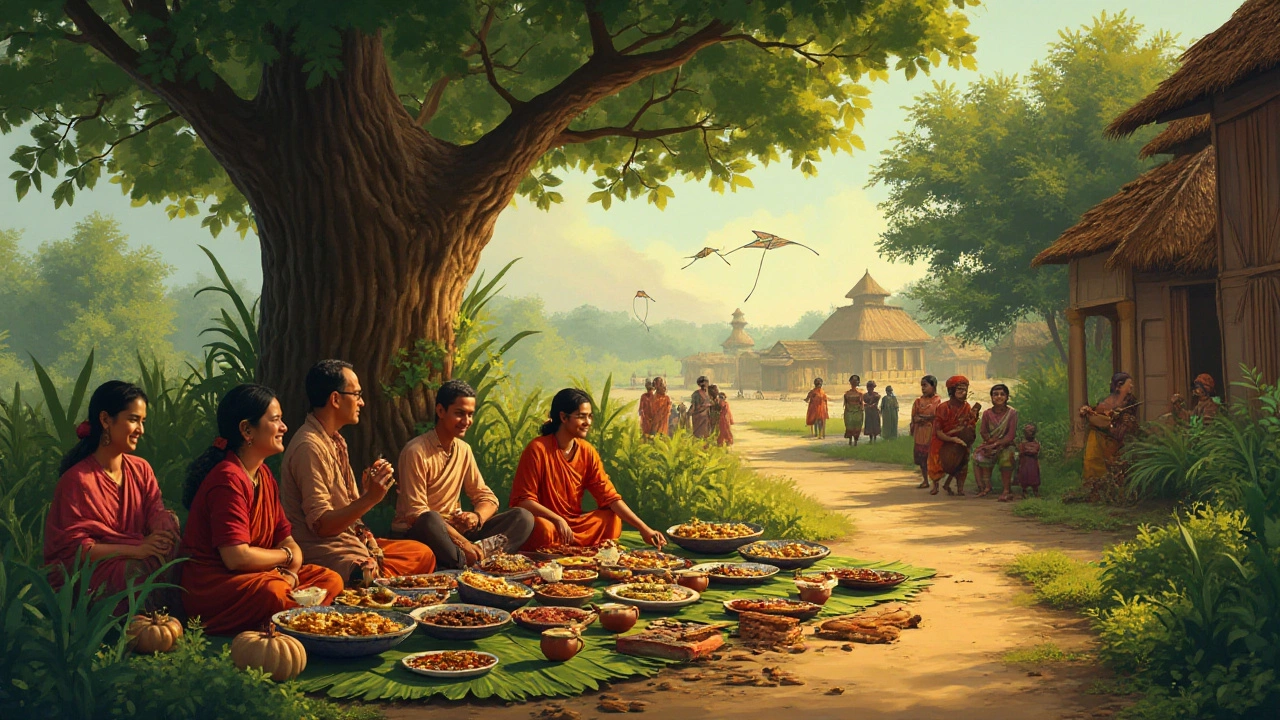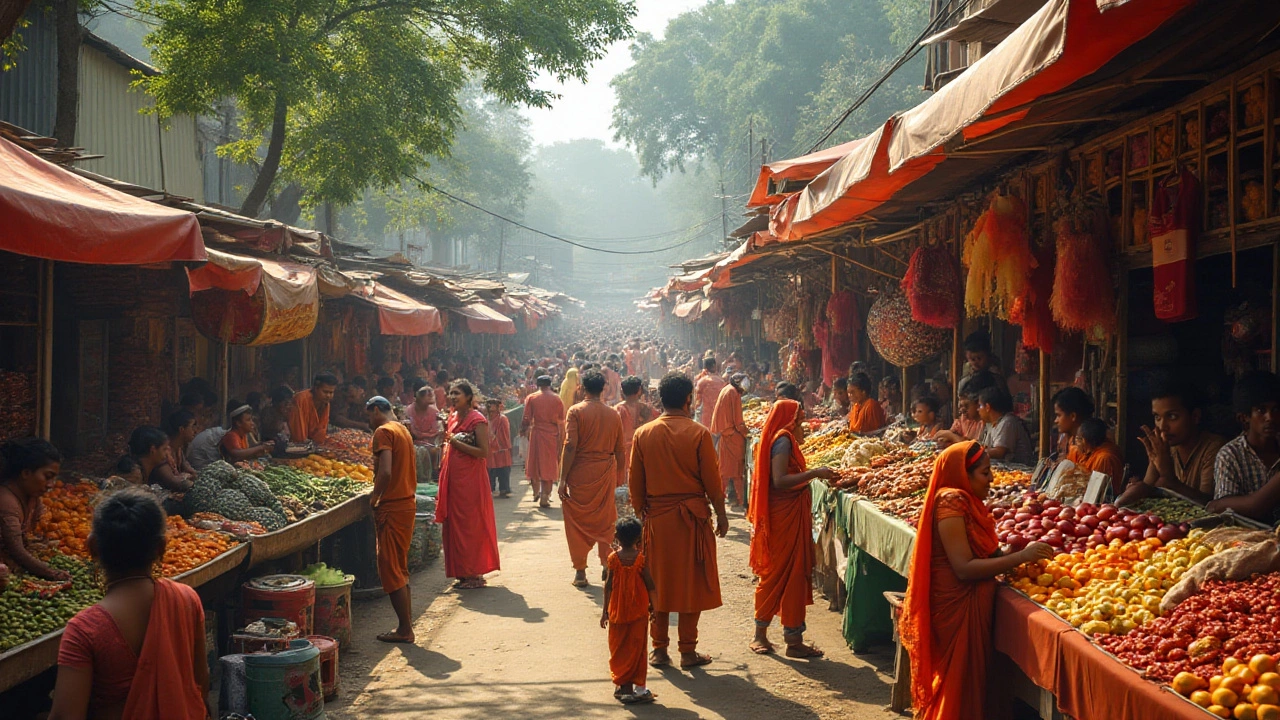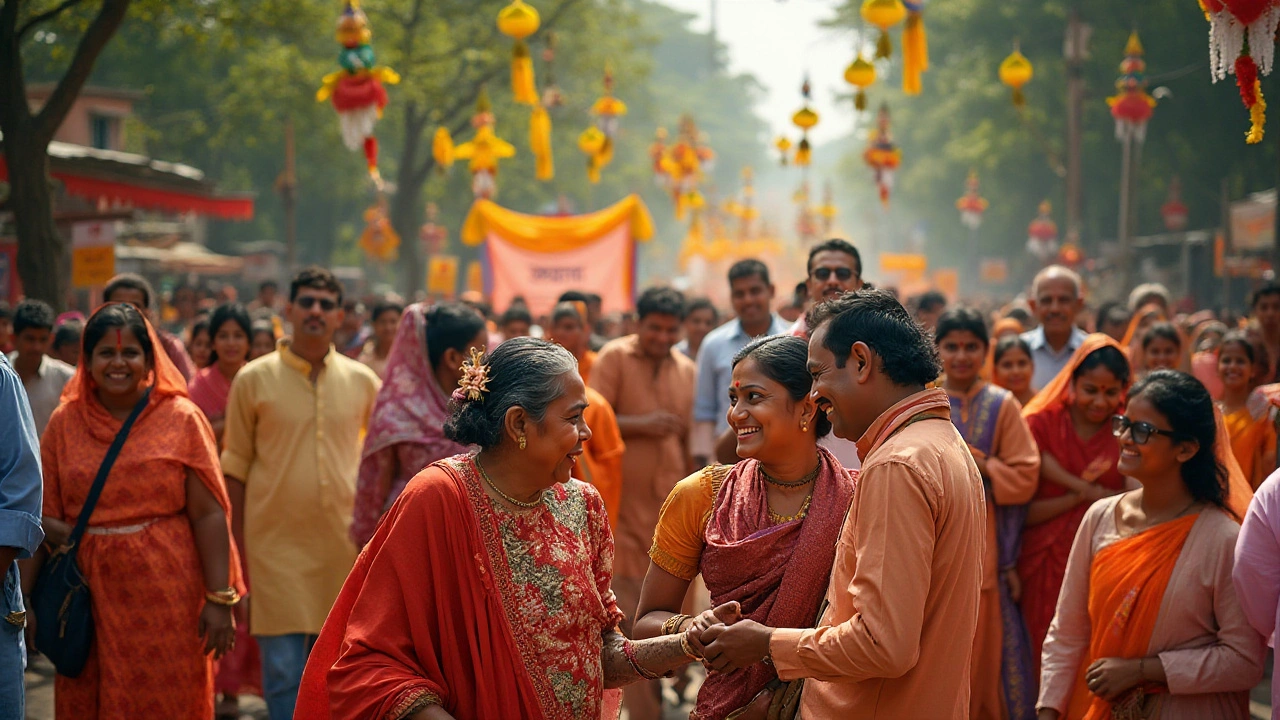In the heart of Bangladesh, where lush landscapes and vibrant communities dominate, a festival known as Pohela Boishakh takes the spotlight each year. This colorful celebration, echoing the first day of the Bengali calendar, is more than just a date; it is a profound expression of cultural identity and joy.
Pohela Boishakh is a day of renewal and hope, uniting people across diverse backgrounds. It brings with it an air of fresh beginnings, characterized by a multitude of vibrant activities and expressions. Streets overflow with parades and markets bustle with energy as people don traditional clothing to celebrate their heritage.
The festivities aren't just visual. They are experienced through the tantalizing smells of culinary delights, as families and friends gather to savor traditional dishes that speak the language of togetherness and nostalgia. At its core, this festival is an embodiment of unity, welcoming the new year with open hearts and festive spirits.
- Origins of Pohela Boishakh
- Traditional Celebrations and Rituals
- Culinary Delights of the Festival
- Cultural Significance and Impact
- Unique Traditions and Modern Adaptations
Origins of Pohela Boishakh
The festival of Pohela Boishakh, heralding the Bengali New Year, is steeped in a rich history that spans centuries, intertwining the cultural, social, and economic threads of the region. This festival is celebrated on the first day of the Bengali calendar, which usually falls on or around April 14th. The origins of this vibrant feast date back to the Mughal era when Emperor Akbar reformed the calendar system. Faced with the task of organizing the harvest tax collection system, he aligned the fiscal year with the agricultural calendar, thus giving birth to the Bangla calendar.
Emperor Akbar's reign was a period where harmonizing cultural practices with administrative necessities became the norm. The introduction of the Bengali calendar was part of these reforms and was initially called 'Fasholi Shon' or the harvest calendar. The synchronization with the agricultural cycle was crucial, as it marked the beginning of the crop season, and symbolized prosperity and growth. The term "Pohela Boishakh" essentially translates to the first day of the month of Boishakh, which fittingly marked the commencement of the new economic cycle for farmers and traders alike.
Over time, the significance of Pohela Boishakh transcended its initial economic purpose and began to weave into the social and cultural fabric of Bengal. It became a day for wiping clean the slate, symbolically resetting financial books in a ceremony known as "Halkhata," which is still practiced today by many business communities. Bangladesh and the Bengali-speaking regions of India both spring into life with communal activities, signifying the importance of this day in restoring and reaffirming social bonds.
As noted by Professor Anisuzzaman, a renowned historian of Bangladesh, "Pohela Boishakh has not only grown as a festival of joy and renewal but as a powerful emblem of cultural unity and resistance against colonial and oppressive regimes throughout history."
The festival's historical context also reflects the struggles and triumphs of the Bengali people. During the Partition of British India in 1947, Pohela Boishakh took on a more pronounced cultural identity in East Bengal, which later became East Pakistan and eventually Bangladesh. It played a symbolic role in the rise of cultural nationalism, particularly during the Language Movement of the 1950s. The celebration of Pohela Boishakh was seen as an assertion of Bengali heritage and identity, which further solidified when Bangladesh gained independence in 1971.
Traditional Celebrations and Rituals
Immersing in the lively spirit of Pohela Boishakh, the Bengali culture unveils its most cherished traditions. The day dawns with the energetic rhythm of ‘Mongol Shobhajatra’, a vibrant procession that marches through the streets, showcasing colorful masks and floats. Initiated by the students of the Faculty of Fine Arts, University of Dhaka, this procession represents hope, harmony, and cultural diversity. Participants, regardless of age, wear red and white attire, symbolizing purity and prosperity, as these colors are auspicious in Bangladeshi culture.
The rituals extend beyond parades. One finds homes adorned with ‘alpana’ – intricate patterns drawn with a paste made from rice flour. These patterns not only beautify spaces but also invoke blessings for the year ahead. It's a day marked by the harmony of dual nature: revitalization and reflection. As the day progresses, people visit temples to offer prayers, seeking divine grace for a prosperous year, while others might choose to introspect, rekindling their bond with traditions.
Food plays an integral role in Pohela Boishakh's traditional celebrations. Markets, known as ‘Panta Bazar’, buzz with life as vendors sell rice soaked in water overnight, known as 'Panta Bhat', a key culinary delight of the festival. This simple dish carries symbolic significance, representing a humble lifestyle. Accompanied by fried hilsa fish, lentil curry, pickles, and dried fish (shutki), it brings families together around a shared table, fostering a sense of unity. Engaging in communal eating, people embrace each other’s company, strengthening familial bonds.
Another essential feature during this festival is the cultural exhibitions showcasing traditional music and dance forms, which captivate enthusiasts. Stages are set in open spaces where renowned artists perform, filling the air with melodious strains of Rabindra Sangeet and Nazrul Giti, both intrinsic to Bengali heritage. As legendary poet Rabindranath Tagore once emphasized the power of music in cultural integration, it is no surprise that his compositions resonate deeply throughout the festival.
"Music fills the infinite between two souls," Tagore’s words ring true, as they encapsulate the communal spirit of Pohela Boishakh.
Apart from music, the festival sees a revival of local games and sports, reminiscent of simpler times. Kite flying, ‘Ha-du-du’, and boat racing rekindle childhood memories while instilling a sense of joy and amusement among participants and spectators alike. The younger generation, often embroiled in the digital realm, finds these traditional pastimes captivating, thus ensuring their continuation.
Such celebrations are not only about preserving tradition but also about adapting to modernity. Many urban areas have embraced modern technologies to enhance celebrations with augmented reality displays and global virtual events, connecting the Bangladeshi diaspora to their roots. This blend of past and present portrays the dynamic nature of Pohela Boishakh, ensuring its relevance and vibrancy for future generations.

Culinary Delights of the Festival
Pohela Boishakh is not only a feast for the eyes, with its brilliant cultural pageantry, but also a feast for the taste buds. Food plays a central role in the celebration, encompassing a rich array of traditional Bengali dishes that are both savory and sweet. These meals are prepared with heartfelt care, bringing families together around tables laden with dishes that echo the agricultural roots and the historic culinary practices of the region. The ambience during the festival is filled with the enticing aroma of delectable recipes that are passed down through generations, reaffirming the deep connection between food and identity in Bangladeshi culture.
At the heart of the culinary spread, you'll often find panta bhat—a simple and comforting dish of fermented rice that is adored for its light tang and cooling effect, particularly beneficial during the heat of April. Traditionally served with fried hilsa fish, lentil soup, and a variety of bhartas (mashed vegetables seasoned with mustard oil and chilies), this dish embodies the essence of Bengali farming communities, where each ingredient reflects the agriculturally rich landscape. Creating an authentic experience, the preparation and consumption of panta bhat symbolize a connection to the earth and the acknowledgment of the toil it takes to produce such bounty.
The sweet offerings during Pohela Boishakh are nothing short of mesmerizing. Signature sweets like roshogolla and sandesh, made from fresh chenna (a type of cottage cheese), are famous not just for their delightful taste but also their cultural significance. These sweets are often exchanged among friends and neighbors, acting as edible symbols of goodwill and prosperity for the new year. Alongside these, people indulge in mishti doi, a thick, creamy yogurt that is naturally sweetened with date palm jaggery, offering a perfect balance of flavor and texture. It is said that 'Ladles are the tools of happiness', and no Bengali celebration would be complete without these quintessential sweets.
In the words of Chitrita Banerji, a noted Bangladeshi culinary expert, "Food is not just about taste or aesthetics here; it’s an embodiment of love and an expression of cultural pride. During Pohela Boishakh, each meal becomes a celebration of heritage that mirrors the rich traditions of Bengal."
These festive dishes extend beyond being mere meals; they are intricate traditions, wrapped in love and shared among families and communities. Meals during Pohela Boishakh often start with inviting the deities to partake in these offerings, thereby rooting these culinary traditions in spirituality. As families gather to partake in these meals, the act itself is an offering of gratitude for the harvest and blessings for a prosperous year ahead. The significance of these gastronomical delights transcends nourishment, painting a vivid picture of joy, togetherness, and resilience that underscores the rich tapestry of Bengali culture.
Cultural Significance and Impact
The vibrant festival of Pohela Boishakh holds an indelible place in the heart of Bangladeshi culture, serving as a beacon of national identity and unity. This celebration is not just about heralding the Bengali New Year; it is an embodiment of collective spirit, shared values, and the preservation of cultural heritage. Across the country, it is a day when differences in age, class, and social status diminish, creating a tapestry of harmony and celebration.
The origins of Pohela Boishakh can be traced back to the Mughal era, when Emperor Akbar introduced the Bengali calendar to facilitate tax collection in the agrarian society. This historical root intertwines the festival with agriculture, highlighting its significance beyond mere festivities. It is a day when farmers prepare for a new harvest season, symbolizing rejuvenation and prosperity across the agricultural plains of this fertile land.
"Pohela Boishakh is not just the first day of the Bengali year; it is a powerful reminder of who we are and the rich tapestry of our cultural narrative," remarked historian and cultural critic Dr. Arif Zaman.
Celebrated with great fervor, this festival encourages Bangladeshis to reflect on their cultural roots and values. Streets come alive with Bengali culture at the forefront; traditional music, dance, and art forms like the folk songs of Baul singers resonate across the land. These cultural expressions are more than entertainment; they serve as a preservation of ancient traditions passed down through generations. Through such practices, Pohela Boishakh strengthens communal bonds, nurturing a sense of belonging among its people.
In recent years, Pohela Boishakh has also evolved to include modern elements. Urban centers witness contemporary parades where innovative floats symbolize the dynamic fusion of old and new traditions. Commercial activities peak during this period, as businesses adopt the vibrant aesthetics of the festival to attract customers, driving economic activity significantly. This dual embrace of tradition and modernity makes the festival appealing to both older and younger generations, ensuring its continuity and relevance.
Cultural Unity Across Borders
Interestingly, Pohela Boishakh transcends borders, fostering a sense of cultural camaraderie with West Bengal, India, where it is also celebrated. This cross-border celebration underscores the shared cultural and linguistic heritage of the Bengali-speaking people, reinforcing ties that go beyond national boundaries. Festivals like these exemplify how cultural practices can unite people, dispelling notions of division through the shared appreciation of history, language, and tradition.
Moreover, the day's emphasis on community participation is a vital aspect of its impact. Schoolchildren partake in cultural performances, educational institutions organize thematic events, and government bodies support communal gatherings, promoting cultural literacy and engagement. Through these activities, the younger generations gain a profound understanding of their cultural identity and the historical significance behind these celebrations.
In essence, Pohela Boishakh is more than an annual festival; it is a powerful cultural institution that shapes the collective consciousness of the Bengali people. Its enduring appeal lies in its ability to adapt, embrace change, and foster a sense of unity and continuity amidst the evolving landscape of modern life.

Unique Traditions and Modern Adaptations
Pohela Boishakh is a fascinating blend of age-old traditions and fresh modern influences that create a dynamic cultural tapestry. One of the most cherished aspects of this festival is the practice of singing the traditional song "Esho He Boishakh," inviting the new year with open hearts. This song, penned by the revered poet Rabindranath Tagore, resonates deeply with Bengali sentiments, marking the essence of starting anew. The day begins with cultural performances in local neighborhoods, where people gather to witness dances, music, and poetry recitations that celebrate the country's artistic heritage. Such performances often take place under the canopy of sprawling banyan trees or community centers, allowing everyone to join in regardless of age or background.
As the festival unfolds, the streets transform into a vibrant mosaic of colors and sounds. Unique to Bangladesh, the Mangal Shobhajatra is a grand procession that has now gained international acclaim. Initiated by the students of Dhaka University in 1989, this parade is filled with colorful floats, masks, and larger-than-life replicas of animals and folk motifs, symbolizing the evils warded off by the community's unity and strength. It's a visual storytelling of the country's cultural identity, manifesting hopes and aspirations in a tangible form. In 2016, UNESCO recognized it as an "Intangible Cultural Heritage of Humanity," underlining its importance and impact on global cultural recognition.
While traditional practices continue to play a pivotal role, modern adaptations have brought new dimensions to Pohela Boishakh. The advent of social media and digital technology has given rise to virtual celebrations, allowing the Bengali diaspora worldwide to partake in the festivities remotely. Online platforms buzz with live streams of events, virtual cultural showcases, and interactive sessions where people can share greetings and sentiments, bridging the gap between Bangladesh and the world.
"Pohela Boishakh is not just a festival; it's a reminder of Bangladesh's cultural resilience and vibrant spirit," states Saira Rahman, a cultural historian.
Another modern shift is seen in the fashion industry, where designers blend traditional crafts with contemporary styles. This fusion creates a unique fashion narrative that resonates with the younger generation, who seeks to honor their roots while embracing global trends. Traditional attire like sarees and punjabis are given modern twists with innovative designs, making them popular not only in Bangladesh but also in international markets.
Moreover, Pohela Boishakh serves as a crucial economic stimulant. The festival sparks a surge in local commerce, from handicrafts to culinary treats. Markets are decked out with an array of colorful goods, drawing both locals and tourists. This seasonal boom, especially in traditional markets, underscores the festival's significance beyond cultural and social dimensions, impacting economic health positively. Such vibrant exchanges during the festival period foster community bonds, emphasizing shared values and collective joys that transcend individual differences.
In the delicious domain of food, traditional dishes such as panta bhaat, hilsa fish, and sweet delicacies play a starring role. However, as dietary preferences evolve, newer culinary experiments find their place on festive menus. This reflects a broader acceptance of diverse tastes, where experimental fusion cuisine meets time-tested recipes, creating a rich gastronomic experience. It showcases the adaptability of Bengali culture in the modern world, meeting new needs while honoring time-honored traditions.
